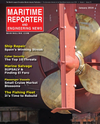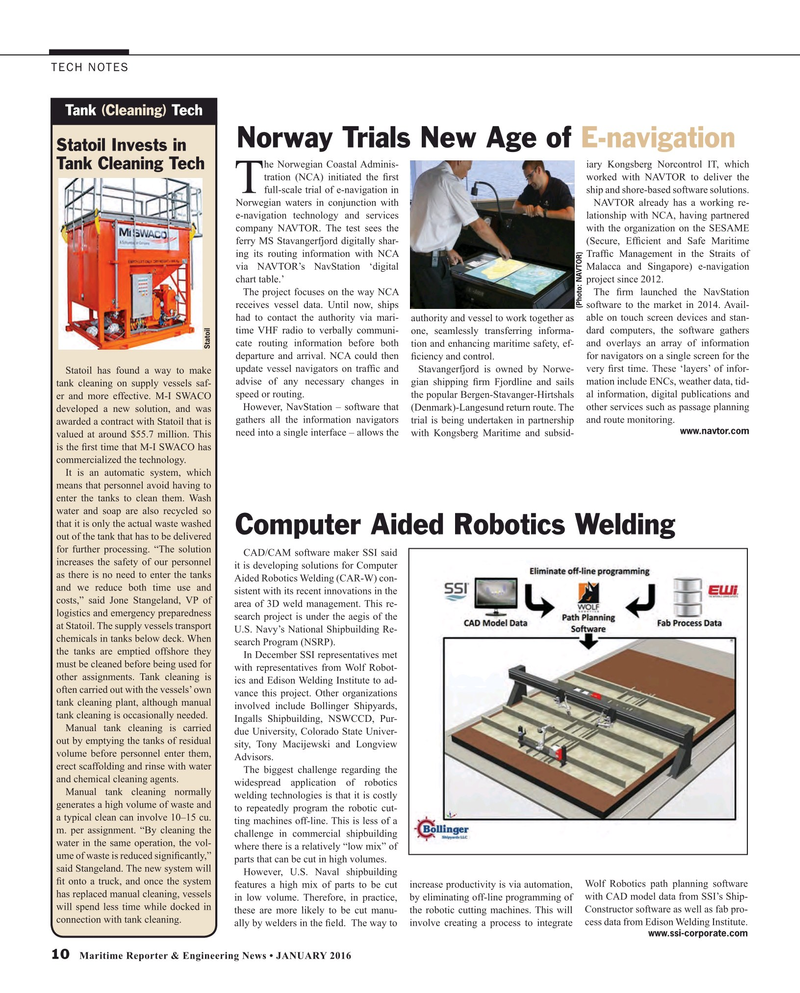
Page 10: of Maritime Reporter Magazine (January 2016)
Ship Repair & Conversion Edition
Read this page in Pdf, Flash or Html5 edition of January 2016 Maritime Reporter Magazine
TECH NOTES
Tank (Cleaning) Tech
Norway Trials New Age of E-navigation
Statoil Invests in he Norwegian Coastal Adminis- iary Kongsberg Norcontrol IT, which
Tank Cleaning Tech tration (NCA) initiated the ? rst worked with NAVTOR to deliver the
Tfull-scale trial of e-navigation in ship and shore-based software solutions.
Norwegian waters in conjunction with NAVTOR already has a working re- e-navigation technology and services lationship with NCA, having partnered company NAVTOR. The test sees the with the organization on the SESAME ferry MS Stavangerfjord digitally shar- (Secure, Ef? cient and Safe Maritime ing its routing information with NCA Traf? c Management in the Straits of via NAVTOR’s NavStation ‘digital Malacca and Singapore) e-navigation chart table.’ project since 2012.
The project focuses on the way NCA The ? rm launched the NavStation receives vessel data. Until now, ships software to the market in 2014. Avail- (Photo: NAVTOR) had to contact the authority via mari- authority and vessel to work together as able on touch screen devices and stan- time VHF radio to verbally communi- one, seamlessly transferring informa- dard computers, the software gathers cate routing information before both tion and enhancing maritime safety, ef- and overlays an array of information
Statoil departure and arrival. NCA could then ? ciency and control. for navigators on a single screen for the update vessel navigators on traf? c and Stavangerfjord is owned by Norwe- very ? rst time. These ‘layers’ of infor-
Statoil has found a way to make advise of any necessary changes in gian shipping ? rm Fjordline and sails mation include ENCs, weather data, tid- tank cleaning on supply vessels saf- speed or routing. the popular Bergen-Stavanger-Hirtshals al information, digital publications and er and more effective. M-I SWACO
However, NavStation – software that (Denmark)-Langesund return route. The other services such as passage planning developed a new solution, and was gathers all the information navigators trial is being undertaken in partnership and route monitoring. awarded a contract with Statoil that is www.navtor.com need into a single interface – allows the with Kongsberg Maritime and subsid- valued at around $55.7 million. This is the ? rst time that M-I SWACO has commercialized the technology.
It is an automatic system, which means that personnel avoid having to enter the tanks to clean them. Wash water and soap are also recycled so that it is only the actual waste washed
Computer Aided Robotics Welding out of the tank that has to be delivered for further processing. “The solution
CAD/CAM software maker SSI said increases the safety of our personnel it is developing solutions for Computer as there is no need to enter the tanks
Aided Robotics Welding (CAR-W) con- and we reduce both time use and sistent with its recent innovations in the costs,” said Jone Stangeland, VP of area of 3D weld management. This re- logistics and emergency preparedness search project is under the aegis of the at Statoil. The supply vessels transport
U.S. Navy’s National Shipbuilding Re- chemicals in tanks below deck. When search Program (NSRP). the tanks are emptied offshore they
In December SSI representatives met must be cleaned before being used for with representatives from Wolf Robot- other assignments. Tank cleaning is ics and Edison Welding Institute to ad- often carried out with the vessels’ own vance this project. Other organizations tank cleaning plant, although manual involved include Bollinger Shipyards, tank cleaning is occasionally needed.
Ingalls Shipbuilding, NSWCCD, Pur-
Manual tank cleaning is carried due University, Colorado State Univer- out by emptying the tanks of residual sity, Tony Macijewski and Longview volume before personnel enter them,
Advisors.
erect scaffolding and rinse with water
The biggest challenge regarding the and chemical cleaning agents.
widespread application of robotics
Manual tank cleaning normally welding technologies is that it is costly generates a high volume of waste and to repeatedly program the robotic cut- a typical clean can involve 10–15 cu. ting machines off-line. This is less of a m. per assignment. “By cleaning the challenge in commercial shipbuilding water in the same operation, the vol- where there is a relatively “low mix” of ume of waste is reduced signi? cantly,” parts that can be cut in high volumes.
said Stangeland. The new system will
However, U.S. Naval shipbuilding ? t onto a truck, and once the system features a high mix of parts to be cut increase productivity is via automation, Wolf Robotics path planning software has replaced manual cleaning, vessels in low volume. Therefore, in practice, by eliminating off-line programming of with CAD model data from SSI’s Ship- will spend less time while docked in these are more likely to be cut manu- the robotic cutting machines. This will Constructor software as well as fab pro- connection with tank cleaning.
ally by welders in the ? eld. The way to involve creating a process to integrate cess data from Edison Welding Institute.
www.ssi-corporate.com 10 Maritime Reporter & Engineering News • JANUARY 2016
MR #1 (10-17).indd 10 1/8/2016 9:49:17 AM

 9
9

 11
11
